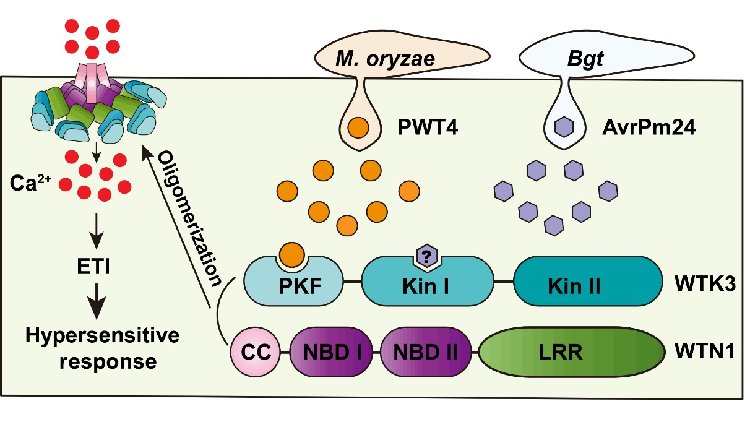Researchers Discover New Immune Mechanism in Wheat Involving Tandem Kinase
The plant immunity team led by Professor Liu Zhiyong from the Institute of Genetics and Developmental Biology at the Chinese Academy of Sciences, along with collaborators from Nanjing Normal University, Yazhouwan National Laboratory, and Xianghu...

This research enhances the understanding of how tandem kinases function, sets a new standard for the cooperation between tandem kinases and NLRs in disease resistance, fills significant gaps in the immune regulatory pathways of tandem kinases, and lays a strong theoretical and practical groundwork for engineering crop varieties with broad-spectrum and multi-pathogen resistance.
The study was published in Science on Friday under the title "A wheat tandem kinase and NLR pair confers resistance to multiple fungal pathogens."
Tandem kinase proteins form a relatively new class of disease resistance proteins found in wheat and barley. Defined by their two or more tandemly arranged kinase domains, these proteins provide resistance against several fungal pathogens, including stripe rust, leaf rust, stem rust, powdery mildew, wheat blast, and smut, making them invaluable for breeding purposes. Previously, Liu’s plant immunity research group at IGDB successfully cloned broad-spectrum powdery mildew resistance genes Pm24 and Pm36, which encode novel tandem kinases sourced from Chinese wheat landraces and wild emmer wheat, respectively. However, unanswered scientific questions remain regarding these novel resistance proteins, including how tandem kinases recognize pathogen effectors, the distinct functional roles of their kinase domains in crop immunity, and the specific immune pathways that tandem kinases utilize to activate disease resistance responses.
By screening EMS-induced susceptible mutants of the powdery mildew resistance gene Pm24, the research team discovered WTN1, a critical element of the WTK3-mediated disease resistance pathway. WTN1, an atypical NLR protein, is closely associated with WTK3. Genetic analyses indicated that WTN1 is essential for WTK3-mediated immunity against wheat powdery mildew, with the WTK3-WTN1 pair activating immune responses through a sensor-executor cooperative model. Remarkably, WTK3 not only provides resistance to wheat powdery mildew but also identifies the wheat blast effector PWT4, initiating immune responses and potentially demonstrating resistance to wheat blast.
Using a multidisciplinary approach that includes plant immunology, biochemical assays, electrophysiological examinations, and evolutionary analysis, the team revealed a highly coordinated relationship between WTK3 and WTN1, enabling wheat to fend off pathogen invasion. WTK3 consists of two crucial functional modules: the first module, which includes the pseudo-kinase fragment and the first kinase domain, is involved in recognizing pathogen effectors, while the second kinase domain interacts with the NLR protein WTN1, creating a strong "defense team." When pathogen invasion occurs, the WTK3-WTN1 complex is swiftly activated, leading to the formation of an ion channel that permits calcium ion influx, thus triggering hypersensitive responses and programmed cell death.
Significantly, previous research established that Pm24 is a distinctive genetic resource derived from Chinese wheat landraces. After extensive backcrossing and marker-assisted breeding, the team successfully integrated Pm24 into various high-yield wheat varieties, and the newly developed disease-resistant germplasms have been widely distributed to domestic institutions for breeding purposes. These developments are expected to mitigate the lack of broad-spectrum powdery mildew resistance genes in key wheat-producing areas of China, create a potential genetic barrier against wheat blast, and offer essential theoretical and technical support for sustainable agricultural practices and industrial advancement.
This research was funded by the National Key R&D Program of China, the Strategic Priority Research Program of the Chinese Academy of Sciences, the National Natural Science Foundation of China, and the Youth Innovation Promotion Association of the Chinese Academy of Sciences.
Rohan Mehta for TROIB News
Discover more Science and Technology news updates in TROIB Sci-Tech












